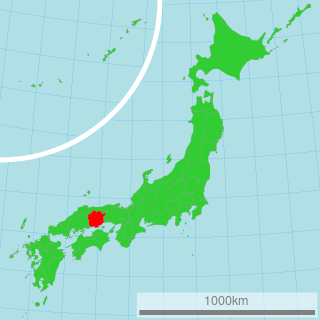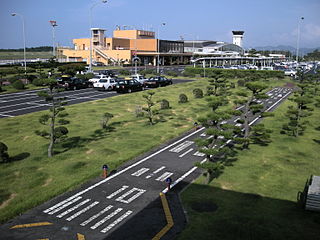
Okayama Prefecture is a prefecture of Japan located in the Chūgoku region of Honshu. Okayama Prefecture has a population of 1,906,464 and has a geographic area of 7,114 km². Okayama Prefecture borders Tottori Prefecture to the north, Hyōgo Prefecture to the east, and Hiroshima Prefecture to the west.

Tottori Prefecture is a prefecture of Japan located in the Chūgoku region of Honshu. Tottori Prefecture is the least populous prefecture of Japan at 570,569 (2016) and has a geographic area of 3,507 km2. Tottori Prefecture borders Shimane Prefecture to the west, Hiroshima Prefecture to the southwest, Okayama Prefecture to the south, and Hyōgo Prefecture to the east.

The Chūgoku region, also known as the San'in-San'yō, is the westernmost region of Honshū, the largest island of Japan. It consists of the prefectures of Hiroshima, Okayama, Shimane, Tottori, and Yamaguchi. In 2010, it had a population of 7,563,428.
Kokufu was a town located in Iwami District, Tottori Prefecture, Japan.
Fukube was a village located in Iwami District, Tottori Prefecture, Japan.
Kawahara was a town located in Yazu District, Tottori Prefecture, Japan.
Mochigase was a town located in Yazu District, Tottori Prefecture, Japan.
Saji was a village located in Yazu District, Tottori Prefecture, Japan.

Yazu is a district located in Tottori Prefecture, Japan.
Ketaka was a town located in Ketaka District, Tottori Prefecture, Japan.
Shikano was a town located in Ketaka District, Tottori Prefecture, Japan.
Aoya was a town located in Ketaka District, Tottori Prefecture, Japan.
Ketaka was a district located in Tottori Prefecture, Japan.

Tottori is the capital city of Tottori Prefecture in the Chūgoku region of Japan.

SC Gainare Tottori are a Japanese football club, based in Yonago, Tottori. They play in the J3 League. Their team colour is green.

Tottori Airport is an airport serving the city of Tottori, Tottori Prefecture, Japan. The airport is owned and operated by the Tottori Prefecture Tottori Airport Authority, and has a passenger volume of approximately 330,000 per year. The Airport has nickname is Tottori Sand Dunes Conan Airport, called after merged with names from Tottori Sand Dunes and Detective Conan of manga artist Gosho Aoyama, who was born in Hokuei.

The Tottori earthquake occurred in Tottori prefecture, Japan at 17:36 local time on September 10, 1943. Although the earthquake occurred during World War II, information about the disaster was surprisingly uncensored, and relief volunteers and supplies came from many parts of the Empire of Japan, including Manchukuo.

The Sendai River is a river in eastern Tottori Prefecture, Japan. The Sendai is 52 kilometers (32 mi) in length and has a drainage area of 1,190 square kilometers (460 sq mi). The source of the river is in the Chūgoku Mountains. The Sendai flows north through Tottori Prefecture into the Sea of Japan. Under the Rivers Act of 1964 it is designated a Class 1 River, and is managed by the Japanese Ministry of Land, Infrastructure, Transport and Tourism. About 200,000 people live along the course of the river. The Sendai River provides sediment to form the Tottori Sand Dunes, the largest dune system in Japan.
This page is based on this
Wikipedia article Text is available under the
CC BY-SA 4.0 license; additional terms may apply.
Images, videos and audio are available under their respective licenses.










